实验一 上机操作初步(2 学时)
一、实验方式:一人一机
二、实验目的:
1、熟悉 VC++语言的上机环境及上机操作过程。
2、了解如何编辑、编译、连接和运行一个 C 程序。
3、初步了解 C 程序的特点。
三、实验内容:
说明:前三题为必做题目,后两题为选做题目。
1、输出入下信息:(实验指导书 P79)
*************************
Very
Good
*************************
2、计算两个整数的和与积。(实验指导书 P81)
3、从键盘输入一个角度的弧度值 x,计算该角度的余弦值,将计算结果输出到屏幕。(书
P3)
4、在屏幕上显示一个文字菜单模样的图案:
=================================
1 输入数据
2 修改数据
3 查询数据
4 打印数据
=================================
5、从键盘上输入两个整数,交换这两个整数。
四、实验步骤与过程:
五、实验调试记录:
六、参考答案:
1、#include
void main( )
{
printf(“********************\n”);
printf(“
Very Good\n”);
printf(“********************\n”);
}
2、#include
void main( )
{
int a,b,c,d;
�
printf(“Please enter a,b:”);
scanf(“%d,%d”,&a,&b);
c=a+b; d=a*b;
printf(“%d+%d=%d\n”,a,b,c);
printf(“%d*%d=%d\n”,a,b,d);
}
3、#include
#include
void main( )
{
double x,s;
printf(“Please input value of x:”);
scanf(“%lf”,&x);
s=cos(x);
printf(“cos(%lf)=%lf\n”,x,s);
}
4、#include
void main( )
{
printf(“==================================\n”);
printf(“
printf(“
1 输入数据
2 修改数据\n”);
3 查询数据
4 打印数据\n”);
printf(“===================================\n”);
}
5、#include
void main( )
{
int x,y,t;
printf(“Please enter x and y:”);
scanf(“%d%d”,&x,&y);
t=x; x=y; y=t;
printf(“After swap:x=%d,y=%d\n”,x,y);
}
实验二 简单的 C 程序设计(4 学时)
一、实验方式:一人一机
二、实验目的:
1、掌握 C 语言的数据类型。
2、学会使用 C 语言的运算符及表达式。
3、掌握不同数据类型的输入输出方法。
三、实验内容:
�
说明:前四题为必做题目,后两题为选做题目。
1、输入 r1、r2,求出圆形垫片面积。(实验指导书 P84)
2、输入华氏温度 h,输出摄氏温度 c。(实验指导书 P85)
3、从键盘输入一个 3 位整数,将输出该数的逆序数。(实验指导书 P89)
4、输入并运行以下程序,分析运行结果。
#include
void main( )
{
int i,j;
i=8; j=10;
printf(“%d,%d\n”,++i,++j);
i=8; j=10;
printf(“%d,%d\n”,i++,j++);
i=8; j=10;
printf(“%d,%d\n”,++i,i);
i=8; j=10;
printf(“%d,%d\n”,i++,i);
}
5、输入三角形三条边的边长,求三角形的面积。(书 P55)
6、输入 3 个字符型数据,将其转换成相应的整数后,求它们的平均值并输出。(书 P55)
四、实验步骤与过程:
五、实验调试记录:
六、参考答案:
1、#include
#define PI 3.14
void main( )
{
float r1,r2;
double s1,s2,s;
printf(“Please enter r1,r2:\n”);
scanf(“%f%f”,&r1,&r2);
s2=r2*r2*PI; s1=r1*r1*PI; s=s2-s1;
printf(“s=%lf\n”,s);
}
2、#include
void main( )
{
float h,c;
�
printf(“请输入华氏温度:”);
scanf(“%f”,&h);
c=5.0/9*(h-32);
printf(“\n 摄氏温度:%f\n”,c);
}
3、#include
void main( )
{
int a,b,c,x,y;
printf(“请输入一个 3 位的正整数:\n”);
scanf(“%d”,&x);
a=x/100;
/*求 x 的百位数*/
b=(x-a*100)/10;
/*求 x 的十位数*/
c=x-a*100-b*10;
/*求 x 的个位数*/
y=c*100+b*10+a;
printf(“%d:%d\n”,x,y);
}
4、运行结果:9,11
8,10
9,8
8,8
5、#include
#include
void main( )
{
int a,b,c;
double area,s;
printf(“Please enter a,b,c:”);
scanf(“%d,%d,%d”,&a,&b,&c);
s=(double)(a+b+c)/2;
area=sqrt(s*(s-a)*(s-b)*(s-c));
printf(“area=%.2lf\n”,area);
}
6、#include
void main( )
{
char a,b,c;
float x;
printf(“Please enter:\n”);
a=getchar(); b=getchar(); c=getchar();
x=(a+b+c)/3.0;
printf(“(a+b+c)/3=%.2f\n”,x);
�
}
实验三 选择结构程序设计(2 学时)
一、实验方式:一人一机
二、实验目的:
1、熟练掌握 if 语句和 switch 语句。
2、练习并掌握多分支选择结构的编程方法。
3、学习调试和修改程序的步骤。
三、实验内容:
说明:前三题为必做题目,后两题为选做题目。
1、读入 3 个分别表示箱子长、宽、高的整数值,判断并输出该箱子是立方体还是长方体。
(实验指导书 P104)
2、输入某一年月,输出该月的天数。(实验指导书 P105)
3、有一函数:
y=
(x<1)
(1≤x<10)
x
2x-1
3x-11 (x≥10)
编写程序,输入 x 值,输出 y 值。
4、从键盘输入一个字符,如果该字符为小写字母,则转换为大写字母输出;如果该字符
为大写字母,则转换为小写字母输出;如果为其他字符,原样输出。(书 P94)
5、输入 4 个整数,要求按由小到大的顺序输出。
四、实验步骤与过程:
五、实验调试记录:
六、参考答案:
1、#include
void main( )
{
int l,w,h;
printf(“请输入箱子的长、宽、高:\n”);
scanf(“%d%d%d”,&l,&w,&h);
if(l==w&&w==h)
/*如果长、宽、高相等,则为立方体*/
printf(“该箱子是立方体。”);
else
printf(“该箱子是长方体。”);
}
2、#include
void main( )
{
int year,month,days;
�
printf(“Please enter year and month:\n”);
switch(month)
{
case 2: if(year%4==0&&year%100!=0||year%400==0)
days=29;
else
days=28;
break;
case 1:case 3:case 5:case 7:case 8:case 10:case 12: days=31; break;
case 4: case 6: case 9: case 11: days=30;
}
printf(“%d 年%d 月有%d 天\n”,year,month,days);
}
3、#include
void main( )
{
float x,y;
printf(“Please input x:\n”);
scanf(“%f”,&x);
if(x<1)
y=x;
else if(x<10)
y=2*x-1;
else
y=3*x-11;
printf(“y=%f\n”,y);
}
4、#include
void main( )
{
char x;
printf(“Enter a char:\n”);
x=getchar();
if(x>=‘a’&&x<=‘z’)
x=x-32;
else if(x>=‘A’&&x<=‘Z’)
x=x+32;
putchar(x);
}
5、#include
void main( )
{
int a,b,c,d,t;
�
printf(“请输入 4 个整数:”);
scanf(“%d%d%d%d”,&a,&b,&c,&d);
if(a>b) {
t=a; a=b; b=t; }
if(a>c) {
t=a; a=c; c=t; }
if(a>d) {
t=a; a=d; d=t; }
if(b>c) {
t=b; b=c; c=t; }
if(b>d) {
t=b; b=d; d=t; }
if(c>d) {
t=c; c=d; d=t; }
printf(“排序结果如下:\n”);
printf(“%d,%d,%d,%d\n”,a,b,c,d);
}
实验四 循环结构程序设计(4 学时)
一、实验方式:一人一机
二、实验目的:
1、熟练掌握 while 语句、do-while 语句和 for 语句。
2、练习并掌握循环结构的嵌套形式。
3、掌握循环结构的程序设计方法。
三、实验内容:
说明:前四题为必做题目,后两题为选做题目。
1、从键盘上输入若干个学生的成绩,统计并输出最高成绩和最低成绩,当输入负数时结
束输入。(实验指导书 P117)
2、求所有的水仙花数。水仙花数是一个 3 位数的自然数,该数各位数的立方和等于该数
本身。(实验指导书 P118)
3、判断输入的某个数是否为素数。若是,输出 YES,否则输出 NO。(书 P123)
4、计算π的近似值。公式如下:π/4=1-1/3+1/5-1/7+……,直到最后一项的绝对值小
于 10-6 为止。(书 P123)
5、计算 s=1!+2!+……+20! 的值并输出。
6、输入 10 个整数,统计并输出其中正数、负数和零的个数。
四、实验步骤与过程:
五、实验调试记录:
六、参考答案:
1、#include
void main( )
{
float x,max,min;
�
printf(“Please input scores:”);
scanf(“%f”,&x);
max=min=x;
while(x>=0)
{
if(x>max)
max=x;
if(x
void main( )
{
int x,y,z;
int k=100;
while(k<=999)
{
x=k/100;
y=(k-x*100)/10;
z=k-x*100-y*10;
if(k==x*x*x+y*y*y+z*z*z)
printf(“%d\n”,k);
k++;
}
}
3、#include
#include
void main( )
{
int i,x,yes,a;
printf(“Enter integer number:”);
scanf(“%d”,&x);
yes=1;
i=2;
a=(int)sqrt((double)x);
while(yes&&i<=a)
if(x%i==0)
yes=0;
i++;
{
}
printf(“%d”,x);
if(yes)
printf(“YES\n”);
�
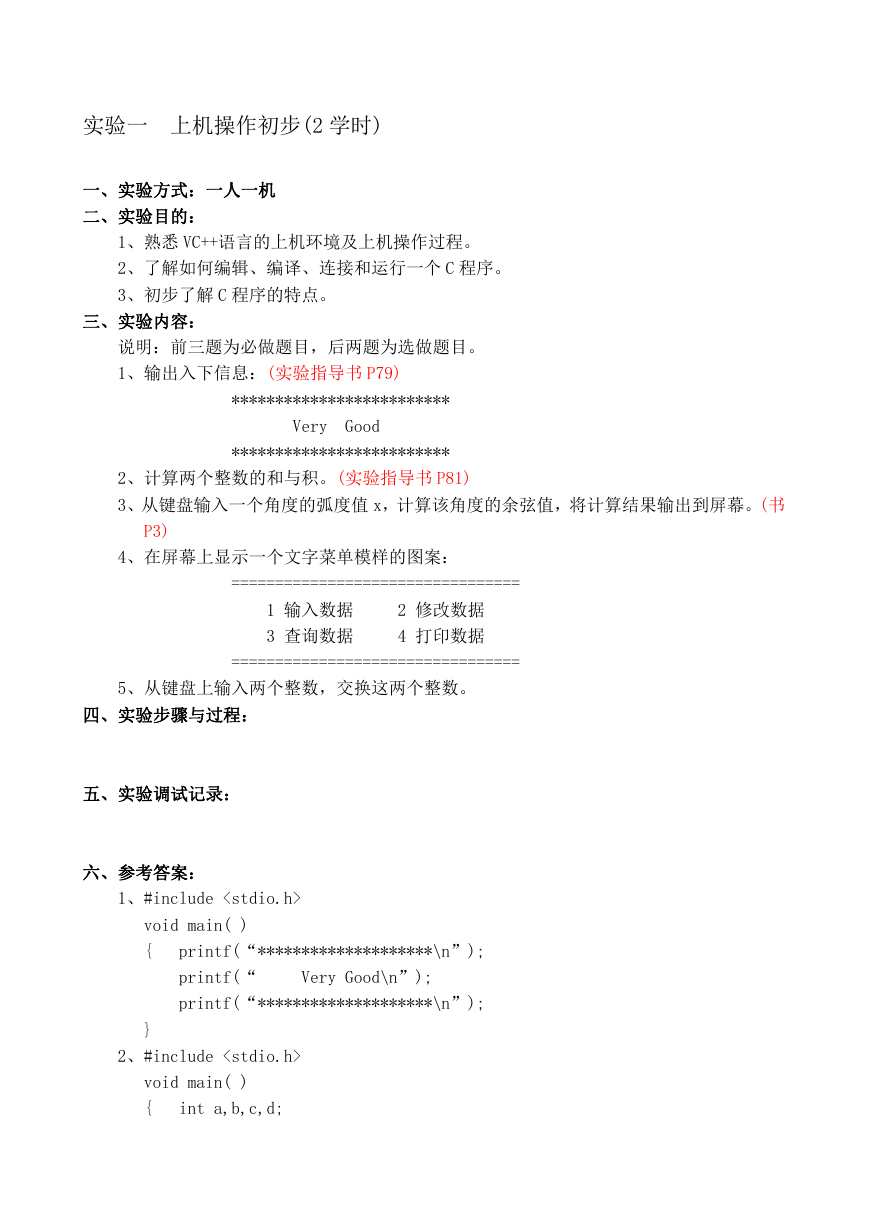
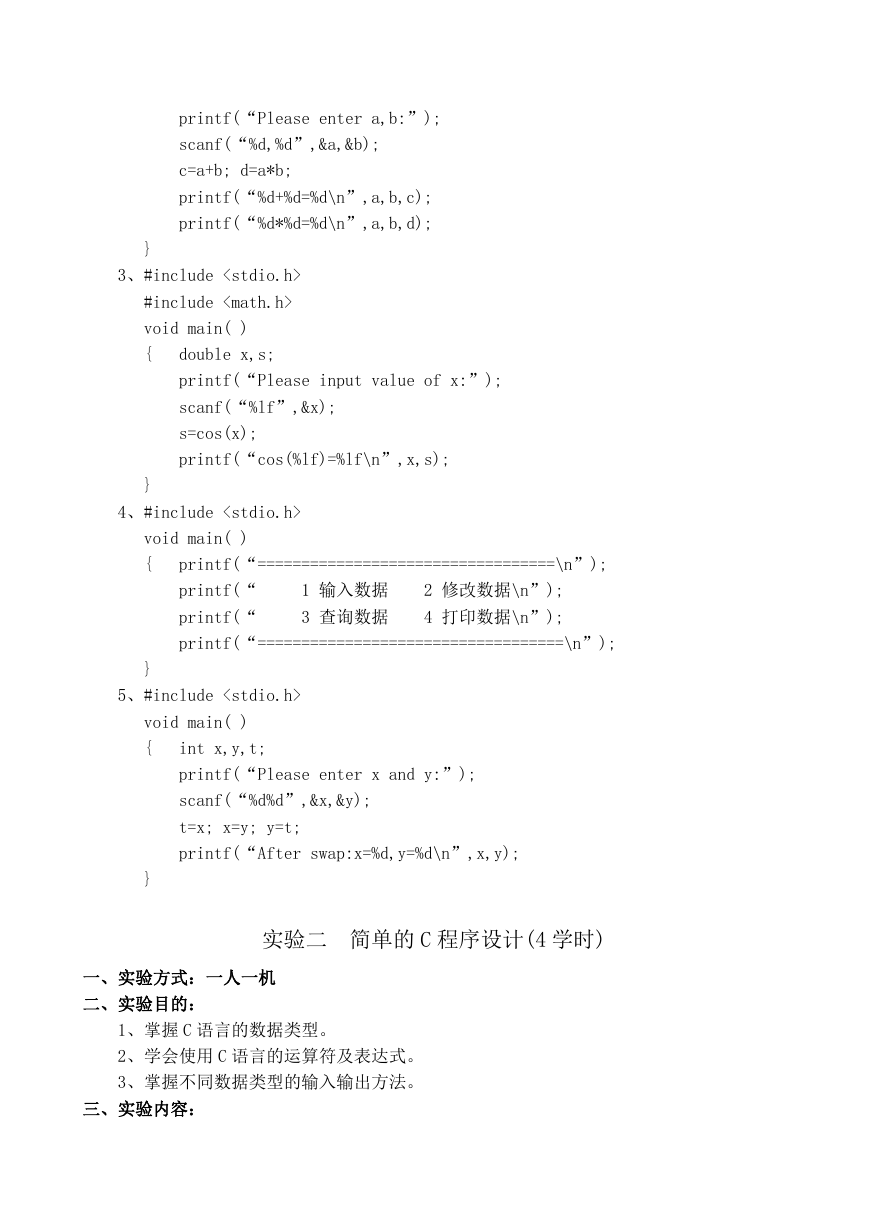
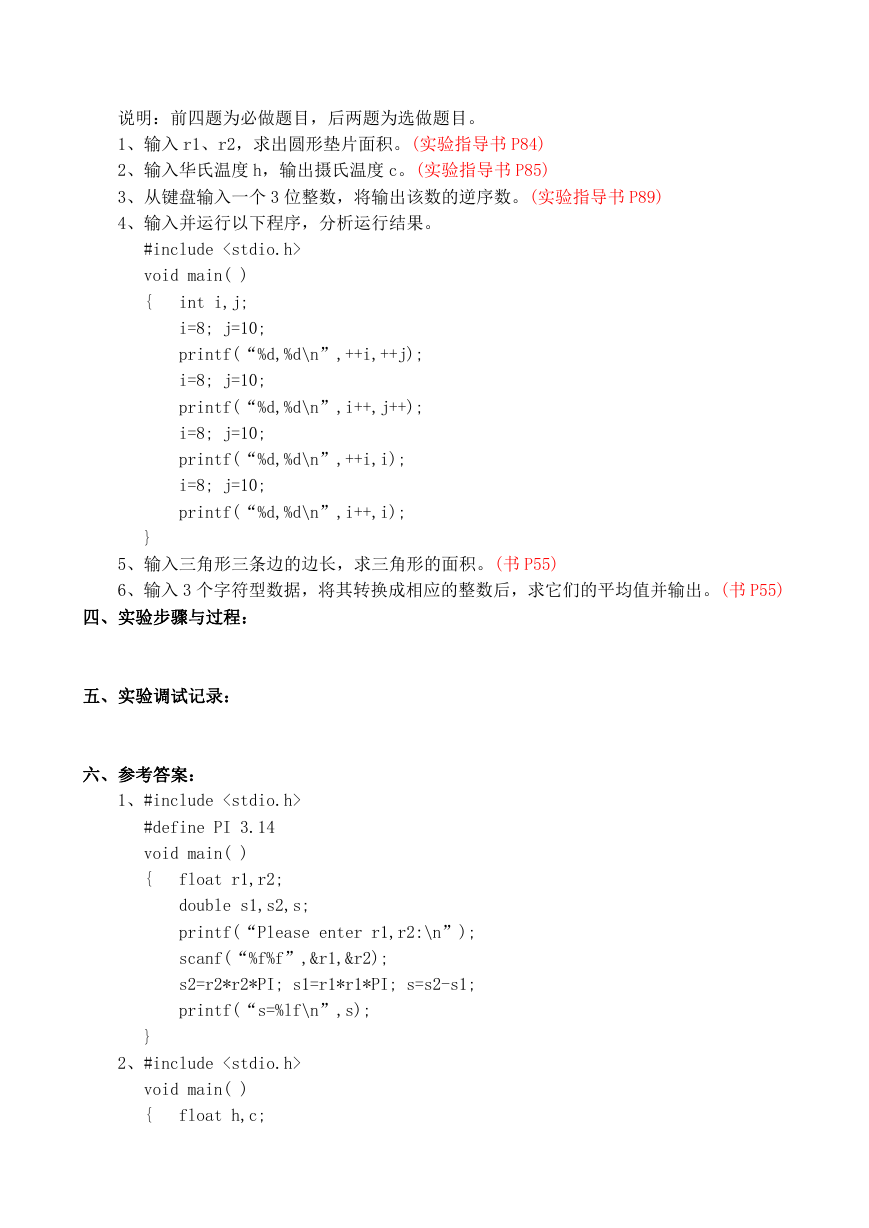
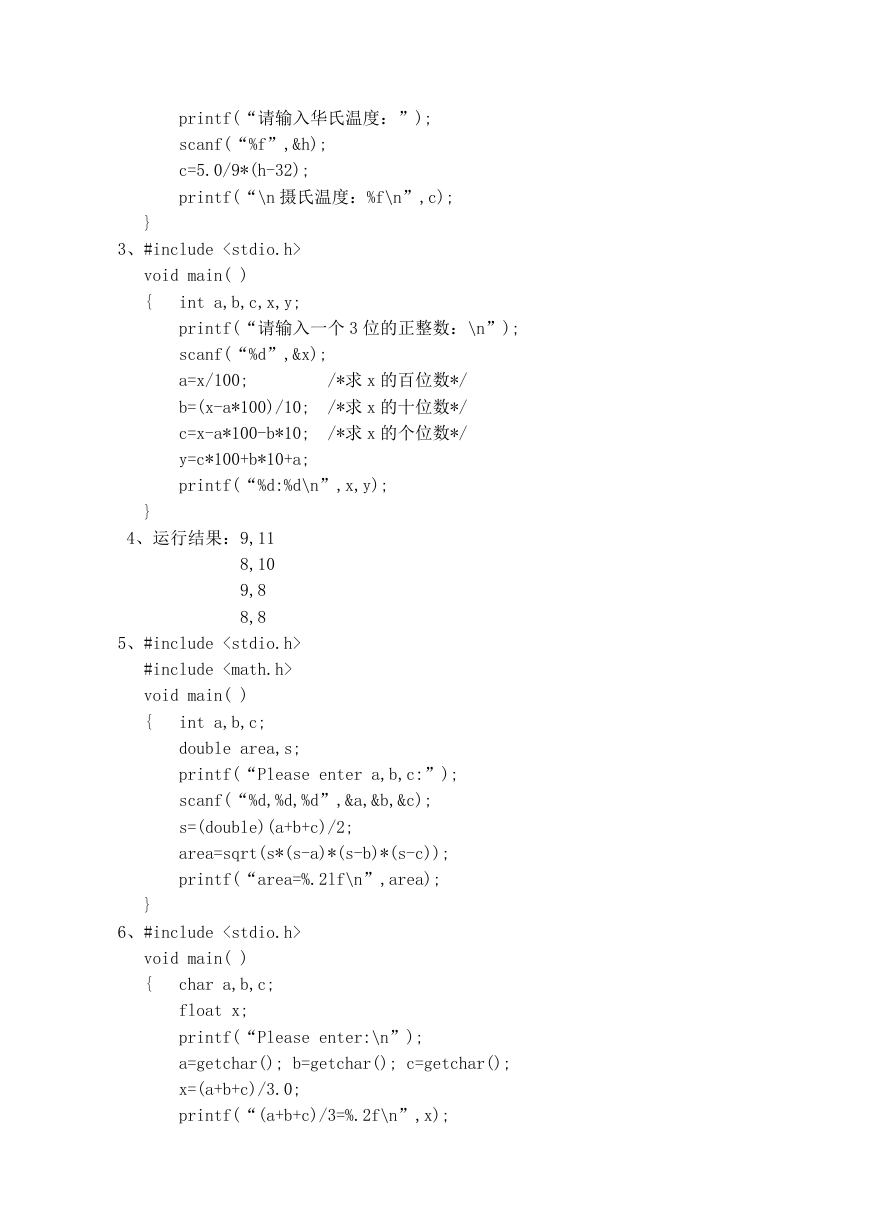
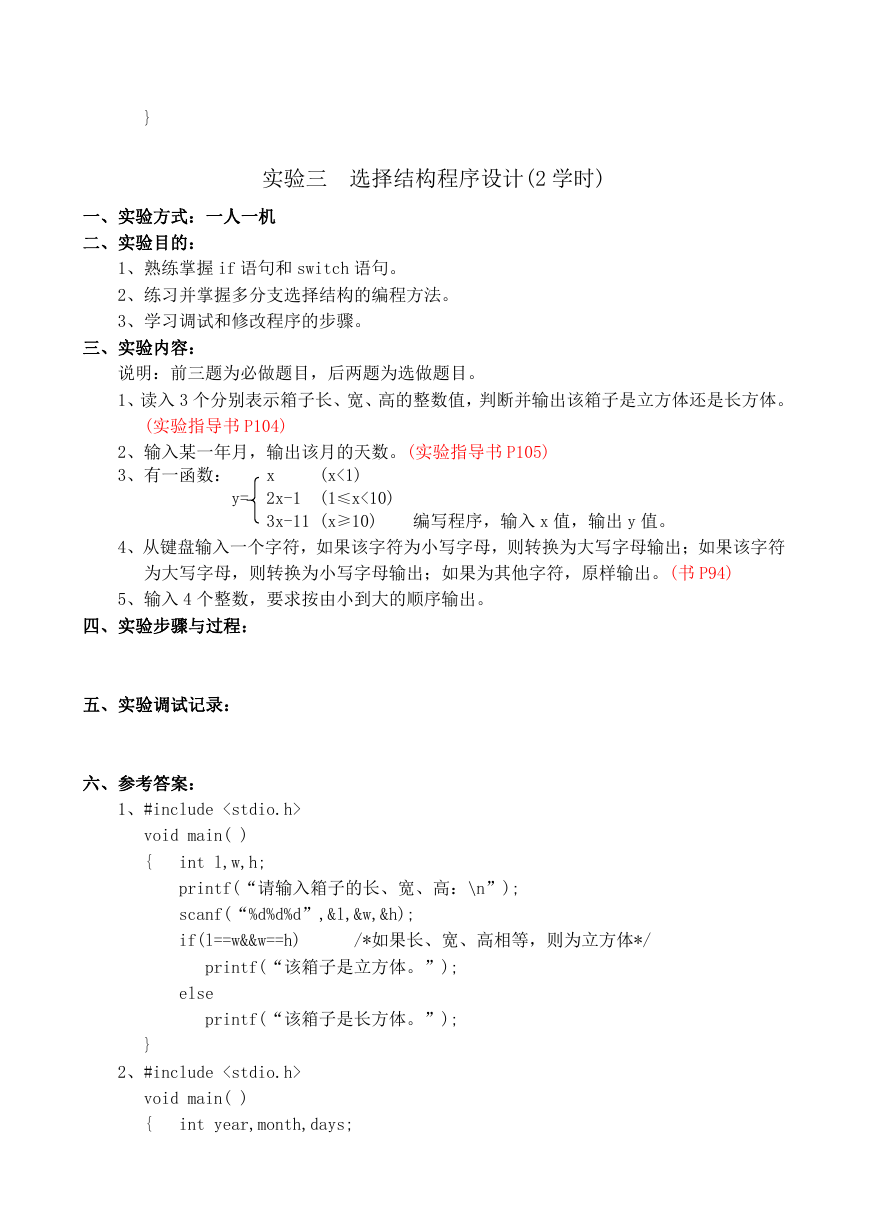
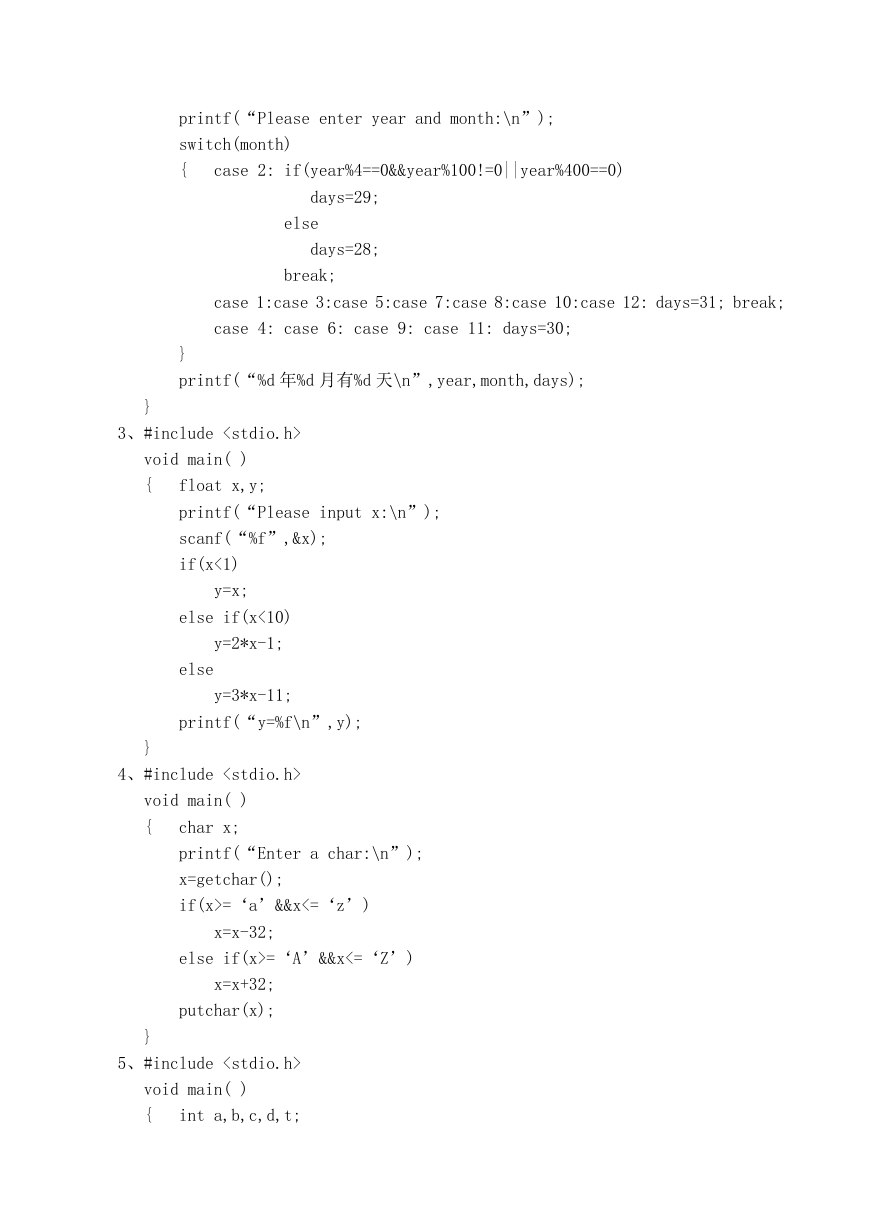
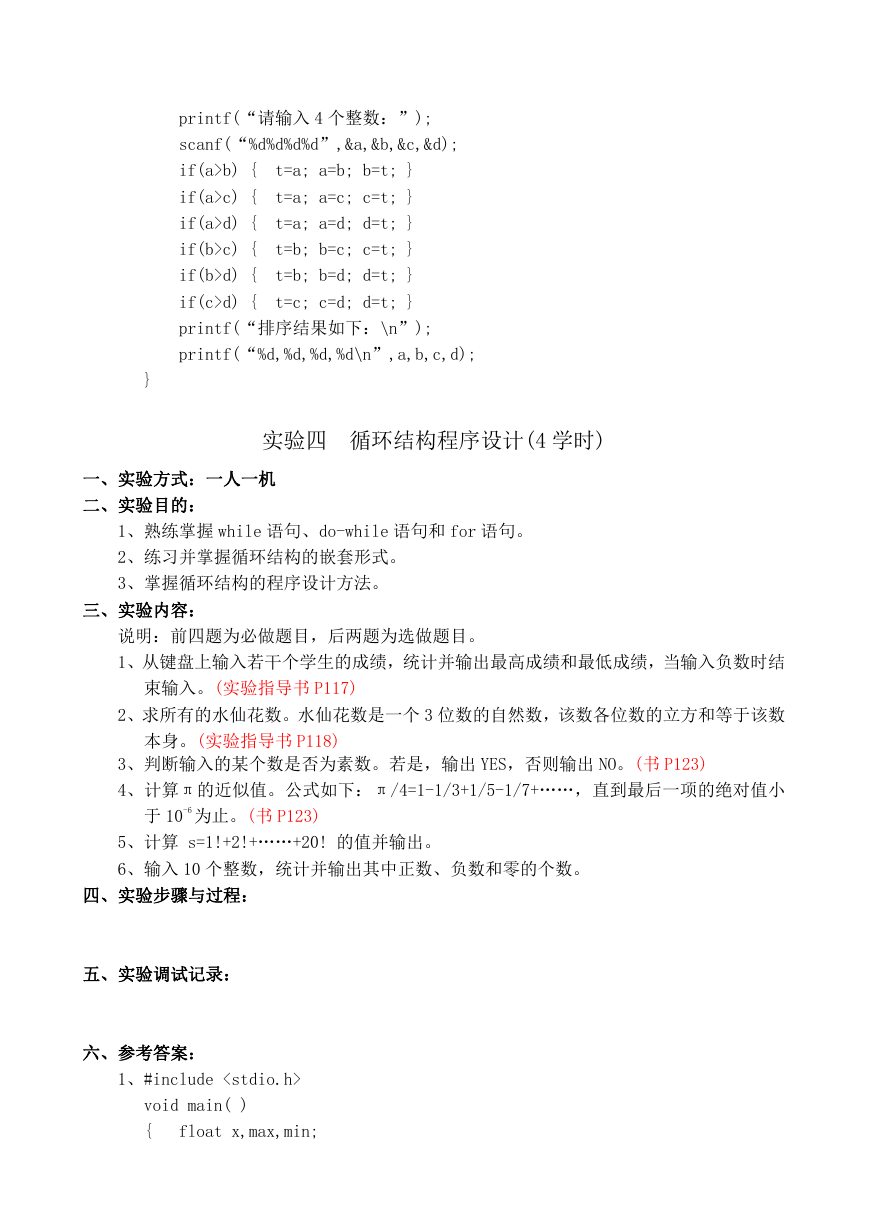
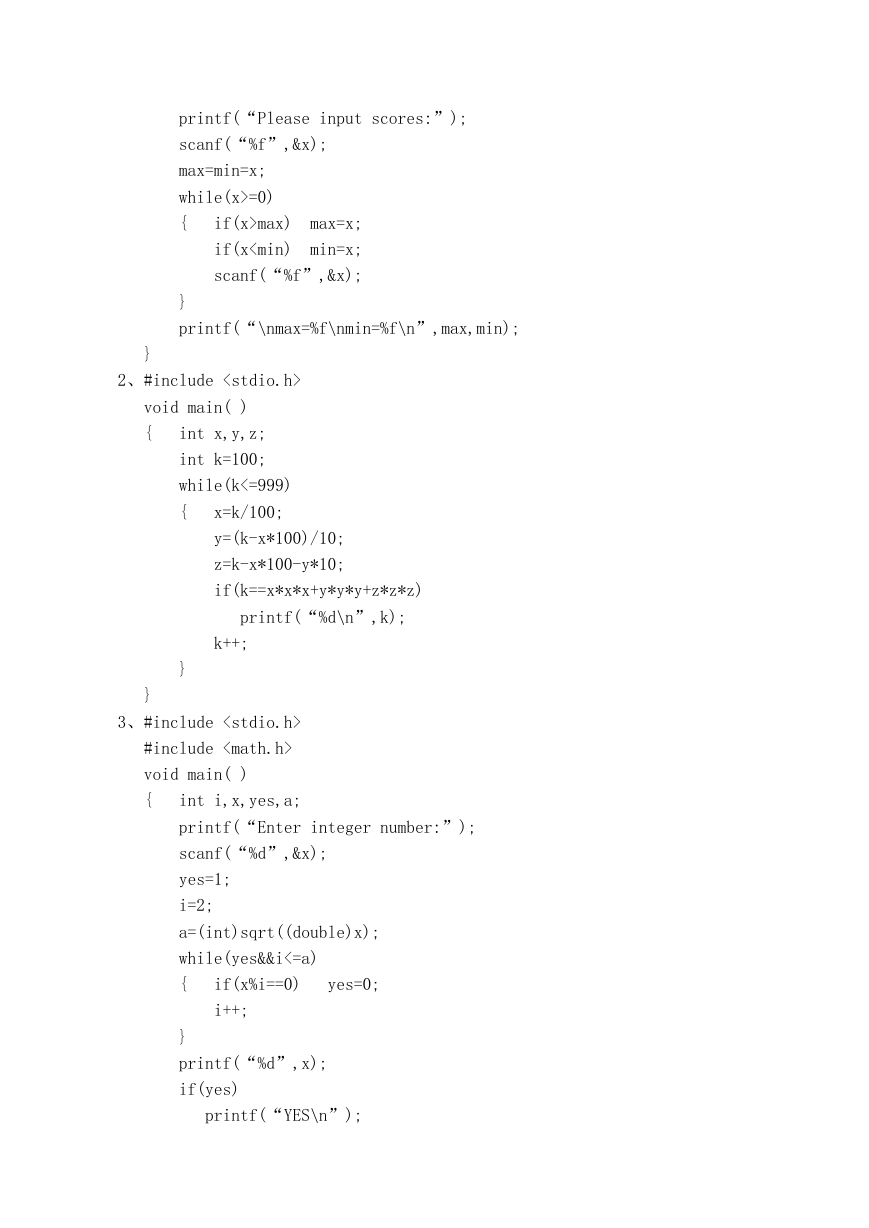








 2023年江西萍乡中考道德与法治真题及答案.doc
2023年江西萍乡中考道德与法治真题及答案.doc 2012年重庆南川中考生物真题及答案.doc
2012年重庆南川中考生物真题及答案.doc 2013年江西师范大学地理学综合及文艺理论基础考研真题.doc
2013年江西师范大学地理学综合及文艺理论基础考研真题.doc 2020年四川甘孜小升初语文真题及答案I卷.doc
2020年四川甘孜小升初语文真题及答案I卷.doc 2020年注册岩土工程师专业基础考试真题及答案.doc
2020年注册岩土工程师专业基础考试真题及答案.doc 2023-2024学年福建省厦门市九年级上学期数学月考试题及答案.doc
2023-2024学年福建省厦门市九年级上学期数学月考试题及答案.doc 2021-2022学年辽宁省沈阳市大东区九年级上学期语文期末试题及答案.doc
2021-2022学年辽宁省沈阳市大东区九年级上学期语文期末试题及答案.doc 2022-2023学年北京东城区初三第一学期物理期末试卷及答案.doc
2022-2023学年北京东城区初三第一学期物理期末试卷及答案.doc 2018上半年江西教师资格初中地理学科知识与教学能力真题及答案.doc
2018上半年江西教师资格初中地理学科知识与教学能力真题及答案.doc 2012年河北国家公务员申论考试真题及答案-省级.doc
2012年河北国家公务员申论考试真题及答案-省级.doc 2020-2021学年江苏省扬州市江都区邵樊片九年级上学期数学第一次质量检测试题及答案.doc
2020-2021学年江苏省扬州市江都区邵樊片九年级上学期数学第一次质量检测试题及答案.doc 2022下半年黑龙江教师资格证中学综合素质真题及答案.doc
2022下半年黑龙江教师资格证中学综合素质真题及答案.doc